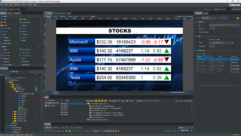The National Systems Contracting Association (NSCA) Expo, held March 12-15 in Dallas, turned out to be another great success this year, despite a rather uncertain economic climate and the threat of impending war. To sum it up in three words:
networking
,
convergence,
and
product line expansion.
Okay, five words, but the last three count as one.
While we couldn’t possibly report on all of the new products, there were quite a few that we can’t help but call some special attention to. Here are some of the things we saw that struck us as especially significant at this year’s NSCA:
Lake Systems
introduced its new Contour DSP loudspeaker controller. A couple of features that make the Contour really exciting are its intuitive, and quite attractive, visual display, and the wireless touch-screen control feature.
Eastern Acoustic Works took the bold step of combining a line array with specialized DSP control in a unique way with its new Digitally Steered Array (DSA) series. It allows the designer to quite literally change the response pattern of the DSA line array speaker, using EAW’s DSAPilot software interface.
Also in the loudspeaker category, it was clear that Altec Lansing Professional is serious about restoring the position of its legendary brand status, showing ten new products at NSCA.
First time exhibitors Broadata Communications’ Concierge Fiberstationattracted a lot of interest. It combines audio, video, data with 12 AVD transport functions in a mini card cage and delivers it all via optical fiber.
Extron Electronics launched its new IP T S2, featuring their IP Link technology. This cool little (quarter-rack space) Ethernet-to-serial box with built-in Web server effectively allows almost any A/V device to be controlled, monitored, and accessed from any computer connected to a LAN, WAN, or the Internet.
Smart Technologies’ DViT technology platform is a touch-screen control system that uses proprietary digital design cameras instead of a touch-sensitive screen surface. This allows any device (finger, stylus, and so on) to control computer screen commands.
Yamaha introduced the Active Field Control (AFC) system, a complete sound field support system that modifies the auditory impression of a room’s acoustics without physical modification.
Peavey expanded the functionality of the MediaMatrix series with the introduction of ControlMatrix, a comprehensive paging solution. ControlMatrix is built on an open architecture, network-based transport model designed to run on CobraNet, standard Ethernet, and serial data systems.
TVOne introduced the C2-770 universal video scaler, which the company claims provides “anything in-anything out” video signal processing and conversions. It features 10 inputs and 5 outputs that can accommodate composite video, S-Video, YCbCr, YpbPr, SDI, all HDTV formats, and any RGBHV resolution up to 2,048 by 2,048.
Another major theme of the show was the dreaded C-word—yes, convergence. The proliferation of networking and networkable products from many manufacturers and many product categories was a clear signal that interoperability and system flexibility is a going to be a design standard for many years to come.
First-time NSCA exhibitor Communications Specialties launched its Pure Digital Fiberlink Flex system, which is an all-digital custom configurable fiber optic link designed to support video, audio, data, and contact closure transmission requirements.
Da-Lite
introduced the Integrated Screen Control
(ISC), which features a tiny Ethernet signal adapter and RS-232 serial control board that can be installed into a motorized screen, effectively making the projection screen a networked device.
Recognizing that a growing number of field based technicians and business people are using PDAs, several manufacturers are designing interfaces that allow them to become a tool specialized for our industry. Gold Line introduced its PDA-based digital RTA technology, CeRTA, which is optimized for use with the Compaq iPAQ. Ivie introduced a PDA-based analyzer featuring the same iPAQ hardware. The Ivie IE-33 attracted a lot of booth traffic because of a killer demo and life-size cardboard cutout giveaway of the IE-33, as well as a daily giveaway of a real unit to the winner of a card drawing. Xantech introduced its MRC88 to the NSCA market, an IR-based control/amplifier that allows control of up to eight audio or video components from remote panels or—you guessed it—your PDA.
There also seemed to be a product trend toward going “downmarket,” expanding product offerings to lower budget applications, perhaps smaller systems—really the bread and butter of most systems integrators and contractors business. This trend has been ongoing in the loudspeaker segment, with nearly every major manufacturer offering compact line array configurations for smaller rental, staging, and installation customers. New compact line arrays at NSCA were shown by Martin Audio (W8LC), Meyer Sound (MILO), McCauley Sound (N-Line and M-Line), Nexo (Geo), L’Acoustics (DV-Dosc), and Electro-Voice (XLCi).
The trend showed up on the electronics side, too—the new BSS Soundweb Lite 3088 provides a less expensive alternative for situations in which the design requires only a maximum of eight inputs and outputs. Biamp Systems introduced several products in its Audia family, including the new AudiaSOLO. AudiaSOLO is smaller and less expensive than the original Audia and is intended for projects that don’t require audio networking capability.
A major enabling technology in the trends of downmarket expansion and networking will surely be Peak Audio’s new CS18101 chip. The new chip should have a major impact on the number and type of manufacturers who can incorporate CobraNet networking technology into lower end product offerings.
Video display technology has been more prevalent at recent NSCA shows, and this year a number of manufacturers showed off technology upgrades and enhanced offerings. Specifically, there was a noticeable emphasis on networkable projectors from manufacturers like Sharp and NEC. And anyone walking by Samsung’s booth was stopped in his or her tracks by the huge 63-inch plasma display on the new model PPM63H1, one of the largest plasma screens on the market.
Generally speaking, this year’s NSCA was much more optimistic than many had expected given the global circumstances. As technology trends continue to accelerate, one can only imagine what kinds of products and programs we’ll see next year at NSCA in Las Vegas.










